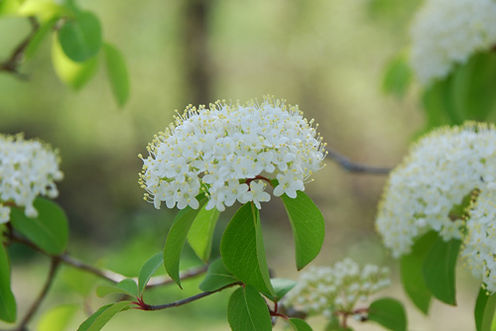black haw (Viburnum prunifolium)
COMMON NAMES:
black-haw
blackhaw viburnum
sheepberry
smooth black-haw
black haw
blackhaw
SCIENTIFIC SYNONYMS:
Viburnum bushii Ashe
Viburnum prunifolium L. var. bushii (Ashe) Palmer & Steyerm.
Viburnum prunifolium L. var. globosum Nash
CONFIRMATION STATUS: Confirmed.
TAXONOMY: The currently accepted scientific name for black haw is
Viburnum prunifolium L.
NATIVE STATUS: Native, United States.
GENERAL BOTANICAL CHARACTERISTICS: This native plant is a
branched woody shrub or small tree up to 15' tall. The young bark of small
branches is gray and slightly rough, while the old bark of the trunk or larger
branches is grey and rough with flat-topped plates. The opposite leaves are
up to 3" long and 1" across; they are ovate or ovate-obovate, glabrous on
both their lower and upper sides, and finely serrated along their margins.
The slender petioles are up to 1" long and reddish. The buds of these leaves
are short. Cymes of flowers about 3-5" across develop from the axils of the
leaves; each cyme is much branched, but sessile at the base. Each flower is
about ¼" across; it has 5 white petals that are well-rounded and longer
than the sepals. There are 5 long stamens with slender white filaments
and yellow anthers, and a small pistil at the center of the flower that is
cream-colored at the base. The flowers have a strong and pleasant fra-
grance; they are produced at about the same time as the leaves. Each
flower is replaced by a fleshy ovoid drupe about 1/3" long; this drupe
becomes blue-black at maturity, sometimes with a whitish bloom. Inside
each drupe, there is a single stone (a seed with a hard coat) that is flat on
one side and convex on the other. The drupes are sweet and edible,
although somewhat thin-fleshed because of their stones. The root system
consists of a branching woody taproot.
REGENERATION PROCESS: Black haw propogates itself by reseeding.
SITE CHARACTERISTICS: Black haw prefers light shade to partial
sun, mesic to dry conditions, and soil that is loamy, clayish-loamy, sandy-
loamy, or somewhat rocky. This shrub can assume somewhat irregular
shapes, depending on lighting conditions.
SUCCESSIONAL STATUS: Insufficient information is currently avail-
able concerning the successional status of black haw. It is found in early
to mature forest successional stages.
SEASONAL DEVELOPMENT: The blooming period occurs from mid-
to late spring.
GENERAL DISTRIBUTION: Black haw primarily occurs east of the
Mississippi River in a broad band from the Mid-Atlantic states west
through the Ohio Valley. It is not naturally distributed in the New Eng-
land states; it has a scattered distribution in the southeastern states
north of Florida.
SKY MEADOWS DISTRIBUTION:
Shrub specimens can be found on trails marked in red.
Bleak House
Appalachian Trail/Old Trail
South Ridge/North Ridge
Gap Run
Snowden
Woodpecker Lane
Sherman's Mill
Rolling Meadows/ Lost Mountain
Fish Pond
HABITAT TYPES AND PLANT COMMUNITIES: Habitats include
rich mesic woodlands, upland woodlands, thinly wooded bluffs, rocky
wooded slopes, limestone glades, woodland borders, and areas along wood-
land paths. This species is found in deciduous woodlands, particularly
where oaks are dominant. It can decline in abundance when a woodland
is invaded by non-native Honeysuckle shrubs, such as Lonicera maackii
(Amur honeysuckle) and Lonicera tartarica (Tartarian honeysuckle).
IMPORTANCE AND USES: The nectar and pollen of the flowers
attract primarily small bees and various flies. Among the bees, these
flower visitors include Cuckoo bees (Nomada spp.), Mason bees, Halictid
bees, and Andrenid bees. Among the flies, these flower visitors include
Syrphid flies, dance flies (Empididae), bee flies (Bombylius spp.), Tachinid
flies, blow flies (Calliphoridae), and Muscid flies. Other flower visitors
include butterflies, skippers, hummingbird moths, and ants, which seek
nectar. The caterpillars of the butterfly Celastrina argiolus (spring/sum-
mer azure) feed on the flowers and buds of Viburnums, while later cater-
pillar instars of the butterfly Euphydryas phaeton (Baltimore) occasionally
feed on their leaves, after migrating from the original host plant (e.g.,
Aureolaria spp.). Several moth caterpillars also feed on Viburnums. An
introduced beetle, Pyrrhalta viburni (Viburnum Leaf Beetle), feeds on
the leaves. Among vertebrate animals, the drupes are occasionally eaten
by birds, primarily during the fall migration; they are also eaten by the
eastern chipmunk, tree squirrels (red, gray, & fox), and the white-
footed mouse. White-tailed deer browse on the twigs and leaves.

Park Activities
Calendar of Events
Volunteer Programs
Sky Meadows Park
Location
Geography
Habitats
Trails
Visiting Park
Crooked Run Valley
Special Projects

